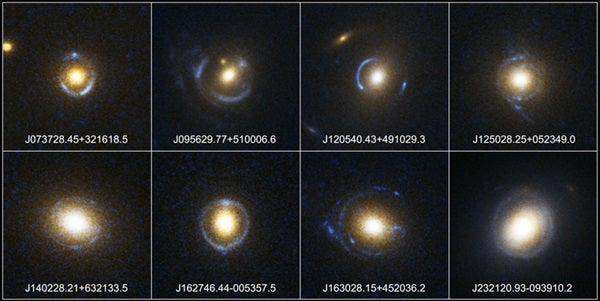Astrophysicists have identified 19 new gravitationally lensed galaxies, eight of which are Einstein rings. This number adds significantly to the 100 lensed galaxies and three visible-light Einstein rings already known.
Researchers using the Sloan Digital Sky Survey (SDSS) found possible lensing candidates and then used the Hubble Space Telescope’s Advanced Camera for Surveys (ACS) for confirmation. The project is part of an ongoing program called the Sloan Lens ACS Survey (SLAC).
“The massive scale of the SDSS, together with the imaging quality of HST, has opened up this unprecedented opportunity for the discovery of new gravitational lenses,” says team coleader Adam Bolton of the Harvard-Smithsonian Center for Astrophysics in Massachusetts.
Massive objects warp space around them, so when light passes close to such an object — a massive elliptical galaxy or galaxy cluster — its path bends. Light from a galaxy lying behind a massive object from our viewpoint will form a ring around the foreground galaxy. Such an image is known as an Einstein ring because Albert Einstein predicted this phenomenon in 1936. If the objects are not precisely lined up, an observer will see arcs of the background galaxy instead of a continuous ring.
With the SDSS data, the astrophysicists can infer the foreground galaxies’ masses, which are greater than their luminous material can account for. This means the foreground galaxies contain significant amounts of dark matter. By studying these galaxies, researchers can learn more about dark matter’s cosmic distribution. “Being able to study these and other gravitational lenses as far back in time as several billion years allows us to directly see whether the distribution of dark and visible mass changes with cosmic time,” explains team coleader Leon Koopmans of the Kapteyn Astronomical Institute in the Netherlands.
The SLAC team will publish its findings in the February issue of The Astrophysical Journal.










